

Compact Muon Solenoid
LHC, CERN
| CMS-TOP-18-005 ; CERN-EP-2019-255 | ||
| Measurement of the top quark pair production cross section in dilepton final states containing one $\tau$ lepton in pp collisions at $\sqrt{s} = $ 13 TeV | ||
| CMS Collaboration | ||
| 29 November 2019 | ||
| JHEP 02 (2020) 191 | ||
| Abstract: The cross section of top quark pair production is measured in the $\mathrm{t\bar{t}}\to (\ell\nu_{\ell})({\tau_\mathrm{h}}\nu_{\tau})\mathrm{b\bar{b}}$ final state, where ${\tau_\mathrm{h}}$ refers to the hadronic decays of the $\tau$ lepton, and $\ell$ is either an electron or a muon. The data sample corresponds to an integrated luminosity of 35.9 fb$^{-1}$ collected in proton-proton collisions at $\sqrt{s} = $ 13 TeV with the CMS detector. The measured cross section is $\sigma_{\mathrm{t\bar{t}}} = $ 781 $\pm$ 7 (stat) $\pm$ 62 (syst) $\pm$ 20 (lumi) pb, and the ratio of the partial width $\Gamma(\mathrm{t}\to\tau\nu_{\tau}\mathrm{b})$ to the total decay width of the top quark is measured to be 0.1050 $\pm$ 0.0009 (stat) $\pm$ 0.0071 (syst). This is the first measurement of the $\mathrm{t\bar{t}}$ production cross section in proton-proton collisions at $\sqrt{s} = $ 13 TeV that explicitly includes $\tau$ leptons. The ratio of the cross sections in the $\ell{\tau_\mathrm{h}}$ and $\ell\ell$ final states yields a value $R_{\ell{\tau_\mathrm{h}}/\ell\ell}=$ 0.973 $\pm$ 0.009 (stat) $\pm$ 0.066 (syst), consistent with lepton universality. | ||
| Links: e-print arXiv:1911.13204 [hep-ex] (PDF) ; CDS record ; inSPIRE record ; HepData record ; CADI line (restricted) ; | ||
| Figures | |

png pdf |
Figure 1:
The $ {\tau _\mathrm {h}}$ $ {p_{\mathrm {T}}}$ distributions for events of the e$ {\tau _\mathrm {h}} $ (left) and $\mu {\tau _\mathrm {h}} $ (right) final states observed prior to fitting. Distributions obtained from data (filled circles) are compared with simulation (shaded histograms). The last bin includes overflow events. The simulated contributions are normalized to the cross section values predicted in the SM. The main processes are shown: the signal, the other ${\mathrm{t} \mathrm{\bar{t}}}$ processes grouped together, single top quark production, W+jets, DY processes, diboson, and multijet production. The ratio of the data to the total SM prediction is shown in the lower panel. The hatched bands indicate the systematic uncertainties and the statistical uncertainties of all simulated samples. Statistical uncertainties on the data points are not visible because of the scale of the figure. |

png pdf |
Figure 1-a:
The $ {\tau _\mathrm {h}}$ $ {p_{\mathrm {T}}}$ distributions for events of the e$ {\tau _\mathrm {h}} $ final state observed prior to fitting. Distributions obtained from data (filled circles) are compared with simulation (shaded histograms). The last bin includes overflow events. The simulated contributions are normalized to the cross section values predicted in the SM. The main processes are shown: the signal, the other ${\mathrm{t} \mathrm{\bar{t}}}$ processes grouped together, single top quark production, W+jets, DY processes, diboson, and multijet production. The ratio of the data to the total SM prediction is shown in the lower panel. The hatched bands indicate the systematic uncertainties and the statistical uncertainties of all simulated samples. Statistical uncertainties on the data points are not visible because of the scale of the figure. |
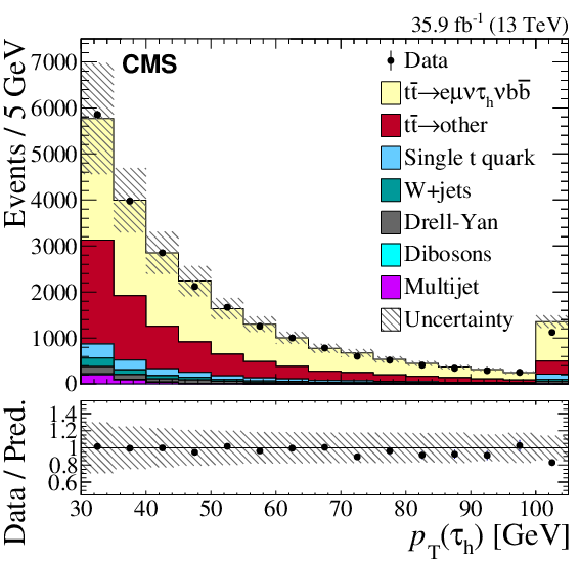
png pdf |
Figure 1-b:
The $ {\tau _\mathrm {h}}$ $ {p_{\mathrm {T}}}$ distributions for events of the $\mu {\tau _\mathrm {h}} $ final state observed prior to fitting. Distributions obtained from data (filled circles) are compared with simulation (shaded histograms). The last bin includes overflow events. The simulated contributions are normalized to the cross section values predicted in the SM. The main processes are shown: the signal, the other ${\mathrm{t} \mathrm{\bar{t}}}$ processes grouped together, single top quark production, W+jets, DY processes, diboson, and multijet production. The ratio of the data to the total SM prediction is shown in the lower panel. The hatched bands indicate the systematic uncertainties and the statistical uncertainties of all simulated samples. Statistical uncertainties on the data points are not visible because of the scale of the figure. |

png pdf |
Figure 2:
Comparison of the signal (${\mathrm{t} \mathrm{\bar{t}}} \to \ell \nu _{\ell} {\tau _\mathrm {h}} \nu _{\tau} \mathrm{b} \mathrm{\bar{b}} $) and the main background of misidentified $ {\tau _\mathrm {h}} $ (${\mathrm{t} \mathrm{\bar{t}}} \to \ell \nu _{\ell} \mathrm{q} \mathrm{\bar{q}} ' \mathrm{b} \mathrm{\bar{b}} $) in the shapes of the normalized distributions of the transverse mass $ {m_{\mathrm {T}}} $ between the lepton and ${{p_{\mathrm {T}}} ^\text {miss}}$ (left), and the $D^\mathrm {min}_{\mathrm {jjb}}$ parameter (see text) of the event categories (right). In the $ {m_{\mathrm {T}}} $ distribution, the signal may extend beyond the W boson mass endpoint because of the two-neutrino final state, whereas the background process cannot. The last bin in both distributions includes overflow events. In the $D^\mathrm {min}_{\mathrm {jjb}}$ distribution, the downward arrow points at the threshold of the cut used ($D^\mathrm {min}_{\mathrm {jjb}} > $ 60 GeV), and the panel on the right shows the fraction of events in the "signal-like'' category where there is only one untagged jet. |
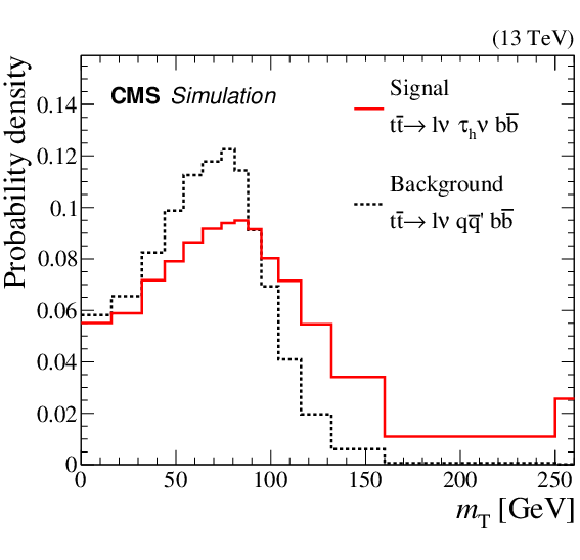
png pdf |
Figure 2-a:
Comparison of the signal (${\mathrm{t} \mathrm{\bar{t}}} \to \ell \nu _{\ell} {\tau _\mathrm {h}} \nu _{\tau} \mathrm{b} \mathrm{\bar{b}} $) and the main background of misidentified $ {\tau _\mathrm {h}} $ (${\mathrm{t} \mathrm{\bar{t}}} \to \ell \nu _{\ell} \mathrm{q} \mathrm{\bar{q}} ' \mathrm{b} \mathrm{\bar{b}} $) in the shapes of the normalized distributions of the transverse mass $ {m_{\mathrm {T}}} $ between the lepton and ${{p_{\mathrm {T}}} ^\text {miss}}$. The signal may extend beyond the W boson mass endpoint because of the two-neutrino final state, whereas the background process cannot. The last bin in the distribution includes overflow events. |

png pdf |
Figure 2-b:
Comparison of the signal (${\mathrm{t} \mathrm{\bar{t}}} \to \ell \nu _{\ell} {\tau _\mathrm {h}} \nu _{\tau} \mathrm{b} \mathrm{\bar{b}} $) and the main background of misidentified $ {\tau _\mathrm {h}} $ (${\mathrm{t} \mathrm{\bar{t}}} \to \ell \nu _{\ell} \mathrm{q} \mathrm{\bar{q}} ' \mathrm{b} \mathrm{\bar{b}} $) in the shapes of the normalized distributions of the $D^\mathrm {min}_{\mathrm {jjb}}$ parameter (see text) of the event categories. The last bin in the distribution includes overflow events. The downward arrow points at the threshold of the cut used ($D^\mathrm {min}_{\mathrm {jjb}} > $ 60 GeV), and the panel on the right shows the fraction of events in the "signal-like'' category where there is only one untagged jet. |
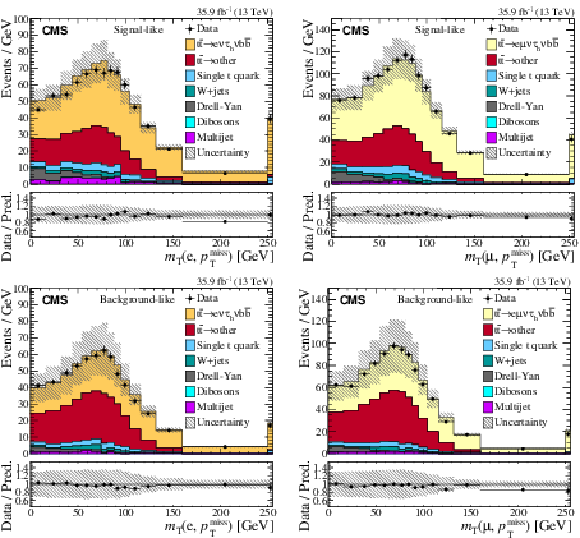
png pdf |
Figure 3:
The transverse mass distributions between lepton (e or $\mu $) and ${{p_{\mathrm {T}}} ^\text {miss}}$, $ {m_{\mathrm {T}}} $, in the signal-like (upper) and background-like (lower) event categories for the e$ {\tau _\mathrm {h}} $ (left) and $\mu {\tau _\mathrm {h}} $ (right) final states observed prior to fitting. Distributions obtained from data (filled circles) are compared with simulation (shaded histograms). The last bin includes overflow events. The simulated contributions are normalized to the cross section values predicted in the SM. The main processes are shown: the signal, the other ${\mathrm{t} \mathrm{\bar{t}}}$ processes grouped together, single top quark production, W+jets, DY processes, diboson, and multijet production. The ratio of the data to the total SM prediction is shown in the lower panel. The vertical bars on the data points indicate the statistical uncertainties, the hatched band indicates the systematic uncertainties and the statistical uncertainties in all simulated samples. |
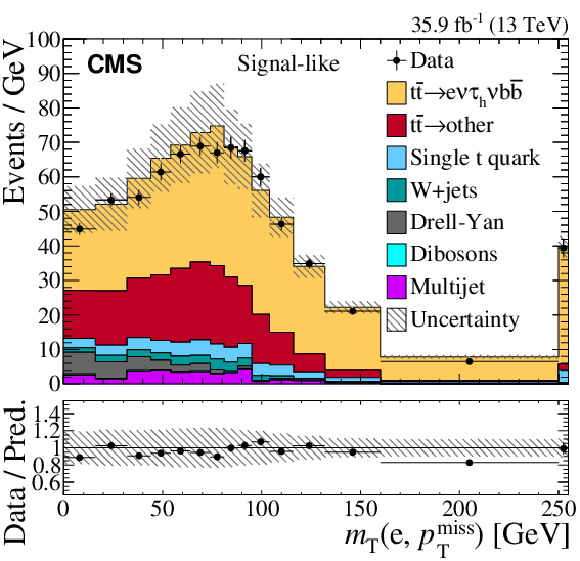
png pdf |
Figure 3-a:
The transverse mass distributions between lepton (e or $\mu $) and ${{p_{\mathrm {T}}} ^\text {miss}}$, $ {m_{\mathrm {T}}} $, in the signal-like event category for the e$ {\tau _\mathrm {h}} $ final state observed prior to fitting. The distribution obtained from data (filled circles) is compared with simulation (shaded histograms). The last bin includes overflow events. The simulated contributions are normalized to the cross section values predicted in the SM. The main processes are shown: the signal, the other ${\mathrm{t} \mathrm{\bar{t}}}$ processes grouped together, single top quark production, W+jets, DY processes, diboson, and multijet production. The ratio of the data to the total SM prediction is shown in the lower panel. The vertical bars on the data points indicate the statistical uncertainties, the hatched band indicates the systematic uncertainties and the statistical uncertainties in all simulated samples. |

png pdf |
Figure 3-b:
The transverse mass distributions between lepton (e or $\mu $) and ${{p_{\mathrm {T}}} ^\text {miss}}$, $ {m_{\mathrm {T}}} $, in the signal-like event category for the $\mu {\tau _\mathrm {h}} $ final state observed prior to fitting. The distribution obtained from data (filled circles) is compared with simulation (shaded histograms). The last bin includes overflow events. The simulated contributions are normalized to the cross section values predicted in the SM. The main processes are shown: the signal, the other ${\mathrm{t} \mathrm{\bar{t}}}$ processes grouped together, single top quark production, W+jets, DY processes, diboson, and multijet production. The ratio of the data to the total SM prediction is shown in the lower panel. The vertical bars on the data points indicate the statistical uncertainties, the hatched band indicates the systematic uncertainties and the statistical uncertainties in all simulated samples. |
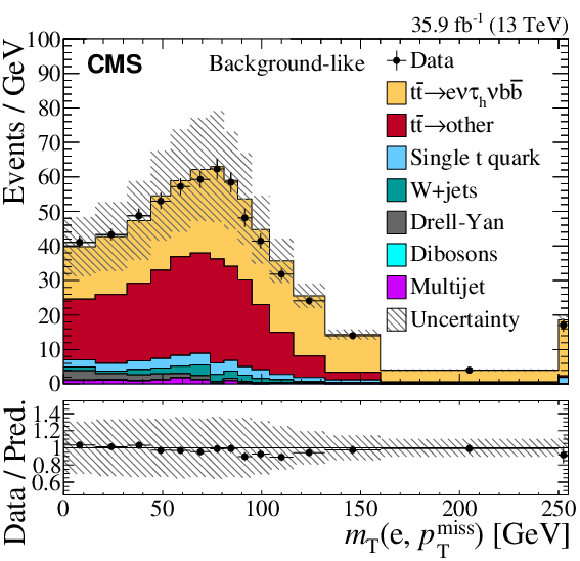
png pdf |
Figure 3-c:
The transverse mass distributions between lepton (e or $\mu $) and ${{p_{\mathrm {T}}} ^\text {miss}}$, $ {m_{\mathrm {T}}} $, in the background-like event category for the e$ {\tau _\mathrm {h}} $ final state observed prior to fitting. The distribution obtained from data (filled circles) is compared with simulation (shaded histograms). The last bin includes overflow events. The simulated contributions are normalized to the cross section values predicted in the SM. The main processes are shown: the signal, the other ${\mathrm{t} \mathrm{\bar{t}}}$ processes grouped together, single top quark production, W+jets, DY processes, diboson, and multijet production. The ratio of the data to the total SM prediction is shown in the lower panel. The vertical bars on the data points indicate the statistical uncertainties, the hatched band indicates the systematic uncertainties and the statistical uncertainties in all simulated samples. |
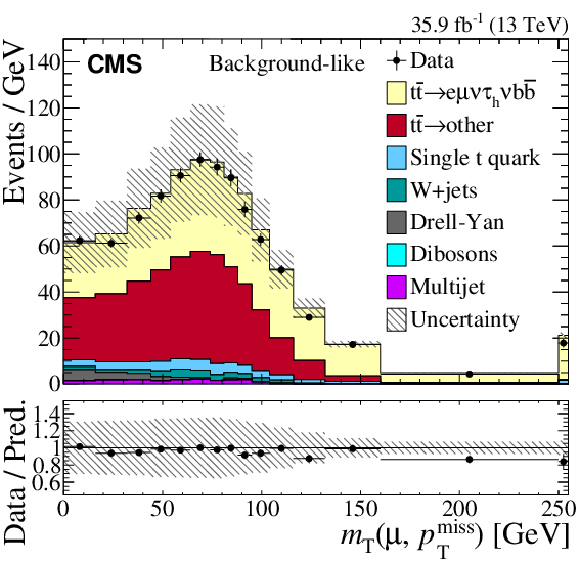
png pdf |
Figure 3-d:
The transverse mass distributions between lepton (e or $\mu $) and ${{p_{\mathrm {T}}} ^\text {miss}}$, $ {m_{\mathrm {T}}} $, in the background-like event category for the $\mu {\tau _\mathrm {h}} $ final state observed prior to fitting. The distribution obtained from data (filled circles) is compared with simulation (shaded histograms). The last bin includes overflow events. The simulated contributions are normalized to the cross section values predicted in the SM. The main processes are shown: the signal, the other ${\mathrm{t} \mathrm{\bar{t}}}$ processes grouped together, single top quark production, W+jets, DY processes, diboson, and multijet production. The ratio of the data to the total SM prediction is shown in the lower panel. The vertical bars on the data points indicate the statistical uncertainties, the hatched band indicates the systematic uncertainties and the statistical uncertainties in all simulated samples. |
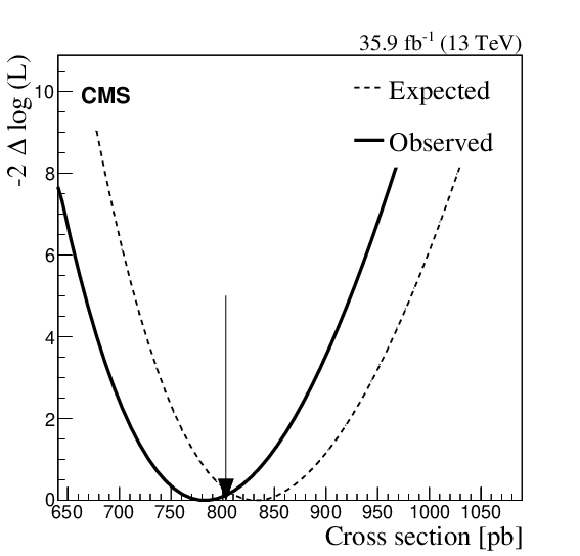
png pdf |
Figure 4:
The expected and observed dependence of the likelihood on the total ${\mathrm{t} \mathrm{\bar{t}}}$ cross section $\sigma _{{\mathrm{t} \mathrm{\bar{t}}}}$. It is derived from the fiducial phase space by a simple extrapolation. The arrow points at the cross section measured in the light dilepton final state. The goodness of the fit determined with a Kolmogorov-Smirnov method yields a $p$ value of 0.24. |
| Tables | |

png pdf |
Table 1:
Expected and observed event yields in the $\ell {\tau _\mathrm {h}} $ ($\ell =\mathrm{e},\mu $) final state for signal and background processes for an integrated luminosity of 35.9 fb$^{-1}$. Statistical and systematic uncertainties are shown. The expected prefit contributions of all processes are presented separately for background-like and signal-like event categories. The statistical uncertainties of the modelling are shown for the processes estimated from the simulation. The multijet contribution and the corresponding statistical uncertainties are estimated using data, as described in Section 6. |
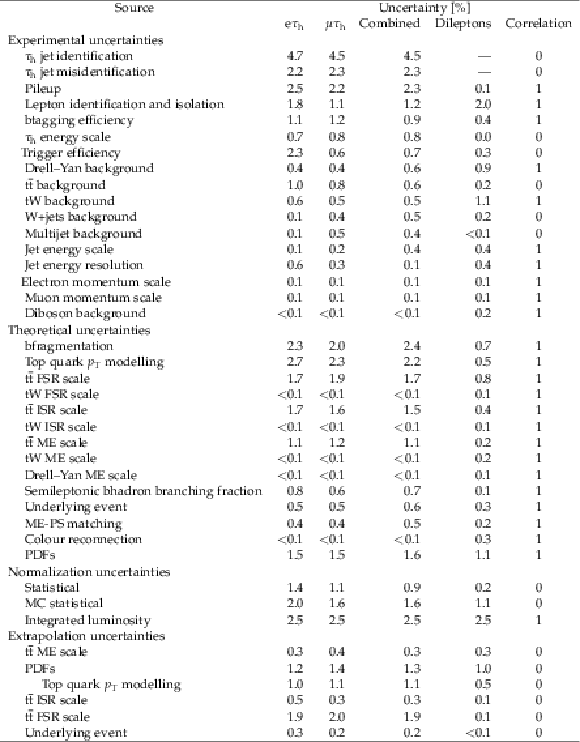
png pdf |
Table 2:
Systematic and statistical uncertainties determined from the fit to the data in the e$ {\tau _\mathrm {h}} $ and $\mu {\tau _\mathrm {h}} $ final states, and their combination. Uncertainties are grouped by their origin: experimental, theoretical, and extrapolation. The uncertainties in the measurement in the dilepton final state [14] used in the partial width ratio estimate are also quoted (column "dileptons"), where the asymmetric extrapolation uncertainties are symmetrized by adding them in quadrature. As both measurements use the same data, some uncertainties are correlated, as shown in the last column. |
| Summary |
| A measurement of the top quark pair production cross section in the $\mathrm{t\bar{t}}\to (\ell \mathrm{g}n_{\ell}) ({\tau_\mathrm{h}} \mathrm{g}n_{\tau}) \mathrm{b\bar{b}}$ channel, where $\ell$ is either an electron or a muon, is performed by CMS in proton-proton collisions at LHC, using a data sample corresponding to an integrated luminosity of 35.9 fb$^{-1}$ obtained at $\sqrt{s} = $ 13 TeV. Events are selected by requiring the presence of an electron or a muon, and at least three jets, of which at least one is b tagged and one is identified as a $\tau$ lepton decaying to hadrons (${\tau_\mathrm{h}}$). The largest background contribution arises from $\mathrm{t\bar{t}}$ lepton+jets events, $\mathrm{t\bar{t}}\to (\ell\mathrm{g}n_{\ell})(\mathrm{q\bar{q}}')\mathrm{b\bar{b}}$, where one jet is misidentified as the ${\tau_\mathrm{h}}$. The background contribution is constrained in a fit to the distribution of the transverse mass of the light lepton and missing transverse momentum system in two event categories, constructed according to the kinematic properties of the jets in the $\mathrm{t\bar{t}}$ lepton+jets final state. The signal enters as a free parameter without constraining the kinematic properties of the $\tau$ lepton. Assuming a top quark mass of 172.5 GeV, the measured total $\mathrm{t\bar{t}}$ cross section $\sigma_{\mathrm{t\bar{t}}}(\ell{\tau_\mathrm{h}}) =$ 781 $\pm$ 7 (stat) $\pm$ 62 (syst) $\pm$ 20 (lumi) pb is in agreement with the standard model expectation. This is the first measurement of the $\mathrm{t\bar{t}}$ production cross section in proton-proton collisions at $\sqrt{s} = $ 13 TeV that explicitly includes hadronically decaying $\tau$ leptons, and it improves the relative precision with respect to the 7 and 8 TeV results [64,65]. The higher precision is achieved through a shape fit to the kinematic distributions of the events, thus better constraining the backgrounds. The measurement of the ratio of the cross sections in the $\ell{\tau_\mathrm{h}}$ final state to the light dilepton cross section [14] yields a value of $R_{\ell{\tau_\mathrm{h}}/\ell\ell}=$ 0.973 $\pm$ 0.009 (stat) $\pm$ 0.066 (syst), consistent with lepton universality. The ratio of the partial to the total width of the top quark $\Gamma(\mathrm{t}\to\tau\mathrm{g}n_{\tau}\mathrm{b})/\Gamma_{\mathrm{total}}=$ 0.1050 $\pm$ 0.0009 (stat) $\pm$ 0.0071 (syst) is measured with respect to the $\mathrm{t\bar{t}}$ inclusive cross section extrapolated from the light dilepton final state, improving the precision over the previous measurements [63,62]. |
| References | ||||
| 1 | LHCb Collaboration | Test of lepton flavor universality by the measurement of the $ \mathrm{B}^0 \to \mathrm{D}^{*-} \tau^+ \nu_{\tau} $ branching fraction using three-prong $ \tau $ decays | PRD 97 (2018) 072013 | 1711.02505 |
| 2 | LHCb Collaboration | Search for lepton-universality violation in $ \mathrm{B}^+\to \mathrm{K}^+\ell^+\ell^- $ decays | PRL 122 (2019) 191801 | 1903.09252 |
| 3 | BaBar Collaboration | Evidence for an excess of $ \bar{\mathrm{B}} \to \mathrm{D}^{(*)} \tau^-\bar{\nu}_\tau $ decays | PRL 109 (2012) 101802 | 1205.5442 |
| 4 | BaBar Collaboration | Measurement of an excess of $ \bar{\mathrm{B}} \to \mathrm{D}^{(*)}\tau^- \bar{\nu}_\tau $ decays and implications for charged Higgs bosons | PRD 88 (2013) 072012 | 1303.0571 |
| 5 | S. Bifani, S. Descotes-Genon, A. Romero Vidal, and M.-H. Schune | Review of lepton universality tests in $ \mathrm{B} $ decays | JPG 46 (2019) 023001 | 1809.06229 |
| 6 | Belle Collaboration | Measurement of the branching ratio of $ \bar{\mathrm{B}} \to \mathrm{D}^{(\ast)} \tau^- \bar{\nu}_\tau $ relative to $ \bar{\mathrm{B}} \to \mathrm{D}^{(\ast)} \ell^- \bar{\nu}_\ell $ decays with hadronic tagging at Belle | PRD 92 (2015) 072014 | 1507.03233 |
| 7 | Belle Collaboration | Measurement of the branching ratio of $ \bar{\mathrm{B}}^0 \rightarrow \mathrm{D}^{*+} \tau^- \bar{\nu}_{\tau} $ relative to $ \bar{\mathrm{B}}^0 \rightarrow \mathrm{D}^{*+} \ell^- \bar{\nu}_{\ell} $ decays with a semileptonic tagging method | PRD 94 (2016) 072007 | 1607.07923 |
| 8 | Belle Collaboration | Measurement of the $ \tau $ lepton polarization and $ R(\mathrm{D}^*) $ in the decay $ \bar{\mathrm{B}} \to \mathrm{D}^* \tau^- \bar{\nu}_\tau $ | PRL 118 (2017) 211801 | 1612.00529 |
| 9 | A. Djouadi | The anatomy of electroweak symmetry breaking. II. The Higgs bosons in the minimal supersymmetric model | PR 459 (2008) 1 | hep-ph/0503173 |
| 10 | G. C. Branco et al. | Theory and phenomenology of two-Higgs-doublet models | PR 516 (2012) 1 | 1106.0034 |
| 11 | CMS Collaboration | Search for charged Higgs bosons in the $ \mathrm{H}^{\pm}\to \tau^{\pm}\nu_\tau $ decay channel in proton-proton collisions at $ \sqrt{s} = $ 13 TeV | JHEP 07 (2019) 142 | CMS-HIG-18-014 1903.04560 |
| 12 | ATLAS Collaboration | Search for charged Higgs bosons decaying via $ \mathrm{H}^{\pm} \to \tau^{\pm}\nu_{\tau} $ in the $ \tau $+jets and $ \tau $+lepton final states with 36 fb$ ^{-1} $ of pp collision data recorded at $ \sqrt{s} = $ 13 TeV with the ATLAS experiment | JHEP 09 (2018) 139 | 1807.07915 |
| 13 | G. Cowan, K. Cranmer, E. Gross, and O. Vitells | Asymptotic formulae for likelihood-based tests of new physics | EPJC 71 (2011) 1554 | 1007.1727 |
| 14 | CMS Collaboration | Measurement of the $ \mathrm{t}\overline{\mathrm{t}} $ production cross section, the top quark mass, and the strong coupling constant using dilepton events in pp collisions at $ \sqrt{s} = $ 13 TeV | EPJC 79 (2019) 368 | CMS-TOP-17-001 1812.10505 |
| 15 | CMS Collaboration | The CMS trigger system | JINST 12 (2017) P01020 | CMS-TRG-12-001 1609.02366 |
| 16 | CMS Collaboration | The CMS experiment at the CERN LHC | JINST 3 (2008) S08004 | CMS-00-001 |
| 17 | P. Nason | A new method for combining NLO QCD with shower Monte Carlo algorithms | JHEP 11 (2004) 040 | hep-ph/0409146 |
| 18 | S. Frixione, P. Nason, and C. Oleari | Matching NLO QCD computations with parton shower simulations: the POWHEG method | JHEP 11 (2007) 070 | 0709.2092 |
| 19 | S. Alioli, P. Nason, C. Oleari, and E. Re | A general framework for implementing NLO calculations in shower Monte Carlo programs: the POWHEG BOX | JHEP 06 (2010) 043 | 1002.2581 |
| 20 | J. M. Campbell, R. K. Ellis, P. Nason, and E. Re | Top-pair production and decay at NLO matched with parton showers | JHEP 04 (2015) 114 | 1412.1828 |
| 21 | S. Frixione, P. Nason, and G. Ridolfi | A positive-weight next-to-leading-order Monte Carlo for heavy flavour hadroproduction | JHEP 09 (2007) 126 | 0707.3088 |
| 22 | T. Sjostrand et al. | An introduction to PYTHIA 8.2 | CPC 191 (2015) 159 | 1410.3012 |
| 23 | P. Skands, S. Carrazza, and J. Rojo | Tuning PYTHIA 8.1: the Monash 2013 tune | EPJC 74 (2014) 3024 | 1404.5630 |
| 24 | J. Alwall et al. | The automated computation of tree-level and next-to-leading order differential cross sections, and their matching to parton shower simulations | JHEP 07 (2014) 079 | 1405.0301 |
| 25 | J. Alwall et al. | Comparative study of various algorithms for the merging of parton showers and matrix elements in hadronic collisions | EPJC 53 (2008) 473 | 0706.2569 |
| 26 | R. Frederix and S. Frixione | Merging meets matching in MC@NLO | JHEP 12 (2012) 061 | 1209.6215 |
| 27 | E. Re | Single-top Wt-channel production matched with parton showers using the POWHEG method | EPJC 71 (2011) 1547 | 1009.2450 |
| 28 | S. Alioli, P. Nason, C. Oleari, and E. Re | NLO single-top production matched with shower in POWHEG: $ s $- and $ t $-channel contributions | JHEP 09 (2009) 111 | 0907.4076 |
| 29 | NNPDF Collaboration | Parton distributions for the LHC Run II | JHEP 04 (2015) 040 | 1410.8849 |
| 30 | GEANT4 Collaboration | GEANT4--a simulation toolkit | NIMA 506 (2003) 250 | |
| 31 | CMS Collaboration | Measurement of the inelastic proton-proton cross section at $ \sqrt{s}= $ 13 ~TeV | JHEP 07 (2018) 161 | CMS-FSQ-15-005 1802.02613 |
| 32 | M. Czakon and A. Mitov | Top++: A program for the calculation of the top-pair cross-section at hadron colliders | CPC 185 (2014) 2930 | 1112.5675 |
| 33 | S. Dulat et al. | New parton distribution functions from a global analysis of quantum chromodynamics | PRD 93 (2016) 033006 | 1506.07443 |
| 34 | Y. Li and F. Petriello | Combining QCD and electroweak corrections to dilepton production in FEWZ | PRD 86 (2012) 094034 | 1208.5967 |
| 35 | M. Aliev et al. | HATHOR: HAdronic Top and Heavy quarks crOss section calculatoR | CPC 182 (2011) 1034 | 1007.1327 |
| 36 | P. Kant et al. | HatHor for single top-quark production: Updated predictions and uncertainty estimates for single top-quark production in hadronic collisions | CPC 191 (2015) 74 | 1406.4403 |
| 37 | N. Kidonakis | Two-loop soft anomalous dimensions for single top quark associated production with a W- or H- | PRD 82 (2010) 054018 | 1005.4451 |
| 38 | N. Kidonakis | NNLL threshold resummation for top-pair and single-top production | Phys. Part. Nucl. 45 (2014) 714 | 1210.7813 |
| 39 | J. M. Campbell and R. K. Ellis | MCFM for the Tevatron and the LHC | NPPS 205-206 (2010) 10 | 1007.3492 |
| 40 | J. M. Campbell, R. K. Ellis, and C. Williams | Vector boson pair production at the LHC | JHEP 07 (2011) 018 | 1105.0020 |
| 41 | CMS Collaboration | Particle-flow reconstruction and global event description with the CMS detector | JINST 12 (2017) P10003 | CMS-PRF-14-001 1706.04965 |
| 42 | M. Cacciari, G. P. Salam, and G. Soyez | The anti-$ {k_{\mathrm{T}}} $ jet clustering algorithm | JHEP 04 (2008) 063 | 0802.1189 |
| 43 | CMS Collaboration | Performance of electron reconstruction and selection with the CMS detector in proton-proton collisions at $ \sqrt{s} = $ 8 TeV | JINST 10 (2015) P06005 | CMS-EGM-13-001 1502.02701 |
| 44 | CMS Collaboration | Electron and photon performance in CMS with the full 2016 data sample. | CDS | |
| 45 | CMS Collaboration | Performance of the CMS muon detector and muon reconstruction with proton-proton collisions at $ \sqrt{s}= $ 13 TeV | JINST 13 (2018) P06015 | CMS-MUO-16-001 1804.04528 |
| 46 | CMS Collaboration | Performance of reconstruction and identification of $ \tau $ leptons decaying to hadrons and $ \nu_\tau $ in pp collisions at $ \sqrt{s}= $ 13 TeV | JINST 13 (2018) P10005 | CMS-TAU-16-003 1809.02816 |
| 47 | CMS Collaboration | Measurements of inclusive W and Z cross sections in pp collisions at $ \sqrt{s}= $ 7 TeV | JHEP 01 (2011) 080 | CMS-EWK-10-002 1012.2466 |
| 48 | CMS Collaboration | Identification of heavy-flavour jets with the CMS detector in pp collisions at 13 TeV | JINST 13 (2018) P05011 | CMS-BTV-16-002 1712.07158 |
| 49 | Particle Data Group, M. Tanabashi et al. | Review of particle physics | PRD 98 (2018) 030001 | |
| 50 | ATLAS Collaboration | Measurement of the inelastic proton-proton cross section at $ \sqrt{s} = $ 13 TeV with the ATLAS detector at the LHC | PRL 117 (2016) 182002 | 1606.02625 |
| 51 | CMS Collaboration | Jet energy scale and resolution in the CMS experiment in pp collisions at 8 TeV | JINST 12 (2017) P02014 | CMS-JME-13-004 1607.03663 |
| 52 | CMS Collaboration | CMS luminosity measurements for the 2016 data taking period | CMS-PAS-LUM-17-001 | CMS-PAS-LUM-17-001 |
| 53 | OPAL Collaboration | Inclusive analysis of the b quark fragmentation function in Z decays at LEP | EPJC 29 (2003) 463 | hep-ex/0210031 |
| 54 | ALEPH Collaboration | Study of the fragmentation of b quarks into B mesons at the Z peak | PLB 512 (2001) 30 | hep-ex/0106051 |
| 55 | SLD Collaboration | Measurement of the b quark fragmentation function in $ \rm{Z^{0}} $ decays | PRD 65 (2002) 092006 | hep-ex/0202031 |
| 56 | DELPHI Collaboration | A study of the b-quark fragmentation function with the DELPHI detector at LEP I and an averaged distribution obtained at the Z pole | EPJC 71 (2011) 1557 | 1102.4748 |
| 57 | M. G. Bowler | $ \mathrm{e}^{+}\mathrm{e}^{{-}} $ production of heavy quarks in the string model | Z. Phys. C 11 (1981) 169 | |
| 58 | C. Peterson, D. Schlatter, I. Schmitt, and P. M. Zerwas | Scaling violations in inclusive $ \mathrm{e}^{+}\mathrm{e}^{{-}} $ annihilation spectra | PRD 27 (1983) 105 | |
| 59 | CMS Collaboration | Measurement of normalized differential $ \mathrm{t}\overline{\mathrm{t}} $ cross sections in the dilepton channel from pp collisions at $ \sqrt{s}= $ 13 TeV | JHEP 04 (2018) 060 | CMS-TOP-16-007 1708.07638 |
| 60 | CMS Collaboration | Measurement of differential cross sections for top quark pair production using the lepton+jets final state in proton-proton collisions at 13 TeV | PRD 95 (2017) 092001 | CMS-TOP-16-008 1610.04191 |
| 61 | CMS Collaboration | Investigations of the impact of the parton shower tuning in Pythia 8 in the modelling of $ \mathrm{t\overline{t}} $ at $ \sqrt{s}= $ 8 and 13 TeV | CMS-PAS-TOP-16-021 | CMS-PAS-TOP-16-021 |
| 62 | ATLAS Collaboration | Measurements of the top quark branching ratios into channels with leptons and quarks with the ATLAS detector | PRD 92 (2015) 072005 | 1506.05074 |
| 63 | CDF Collaboration | Study of top-quark production and decays involving a tau lepton at CDF and limits on a charged-Higgs boson contribution | PRD 89 (2014) 091101 | 1402.6728 |
| 64 | CMS Collaboration | Measurement of the top quark pair production cross section in pp collisions at $ \sqrt{s} = $ 7 TeV in dilepton final states containing a $ \tau $ | PRD 85 (2012) 112007 | CMS-TOP-11-006 1203.6810 |
| 65 | CMS Collaboration | Measurement of the $ \mathrm{t\bar{t}} $ production cross section in pp collisions at $ \sqrt {s} = $ 8 ~TeV in dilepton final states containing one $ \tau $ lepton | PLB 739 (2014) 23 | CMS-TOP-12-026 1407.6643 |

|
Compact Muon Solenoid LHC, CERN |

|

|

|

|

|

|